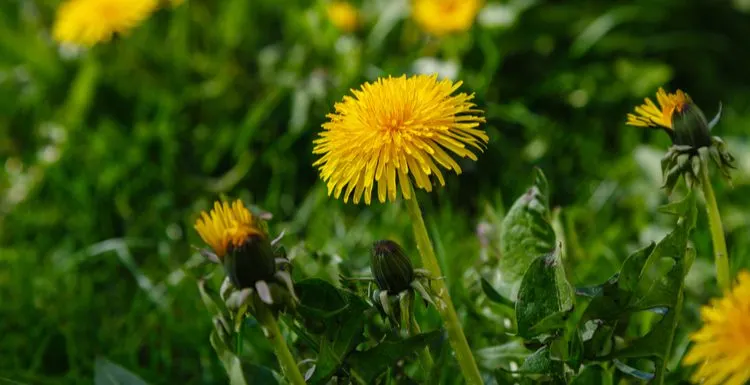Wondering how to get rid of dandelions?
These intrusive weeds are every homeowner’s worst nightmare, and ridding your yard of them seems like a full-time job.
Read on to learn the easy way to quickly get rid of them.
Have a Dandelion Problem? Try This.
They come in the spring, stay through the summer, and thrive in the fall, leaving us homeowners wondering how to get rid of these unwanted guests‒ dandelions.
It’s a more straightforward process than you might think, but you’ll have to get down and dirty. Take a look at our three easy steps to get rid of these pesky weeds in your yard.
Removing the plant from the source is the only sure way to get rid of dandelions. Get to their roots, and you can successfully rid your lawn of these common lawn weeds.
Whether you choose to do it yourself or opt for a professional lawn care service, a good, consistent treatment is just what you need to get a weed-free lawn.
How to Get Rid of Dandelions
Step 1: Dig Up the Weed
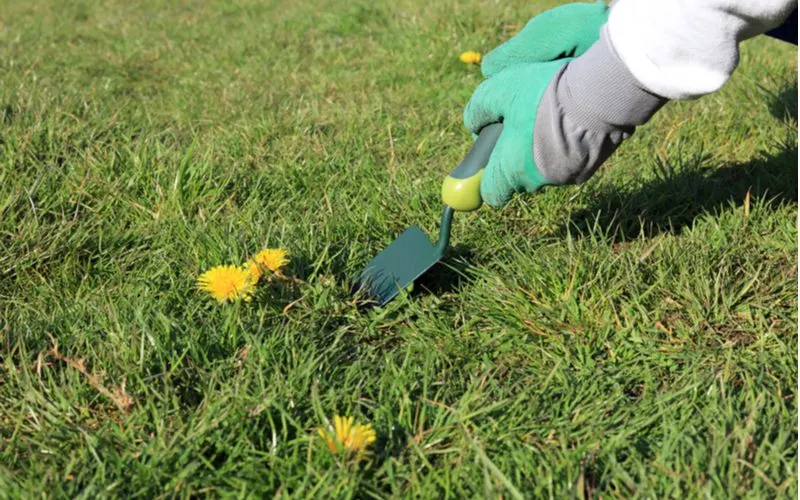
Dean Clarke/Shutterstock
To start digging up these pesky weeds, begin with a moist lawn. Just like naturally kinky hair, dandelions are much easier to manage when wet. After wetting the soil around the plant, or after a good storm, wait at least 30 minutes for the water to seep.
Once your soil absorbs enough moisture, pulling will be much easier. Then, take your gardening tool (preferably a garden spade or hoe) and center it next to the thick taproot lodged in the dirt.
Using your tool, wiggle and pry the root upward to loosen its grip. Yes, you’ll need to put your back into it.
If that dandy is stubborn and decides it’s not leaving its wonderful home in your lawn, use your tool to form another opening in the soil directly next to the root. Do this as many times as necessary until you’re able to get a grip on the root.
When you muster up enough strength, grab that bull by the horns and pull. Seriously, grab the flower’s leaves and pull up as much as you can.
It’s crucial to wiggle it up as much as possible before attempting to pull because the root is thick and won’t go gently into the night without a fight. Too much pulling with not enough grip will result in you tearing off the leaves and leaving the root intact.
Step 2: Demolish the Root
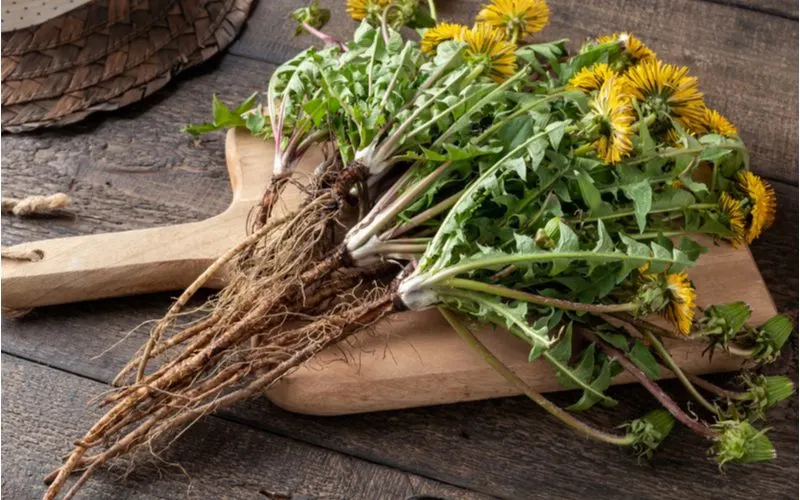
Madeline Steinbach/Shutterstock
Chances are that if you got to the first step, you already realized how daunting a task pulling roots can be. Unfortunately, you can’t give up now. Doing so will result in more dandelions growing from the root you left in the soil.
Dandelion roots can grow as deep as 18 inches underground, so you’re going to need to pry your tool in there. Use your foot or whatever method you need to to get your tool deeper into the soil.
The deeper you get under the soil, the more likely you are to dig up the root. If you’re stumped and can’t get the last bit of the root out, no worries. There are several herbicides to finish off the remains.
Herbicides
Commercial and homemade herbicides will finish off the root; however, there are many misconceptions about what kind of herbicide actually kills the plant and what kind just delays the growing process. Generally speaking, though, broadleaf herbicides are the most effective type.
Some of the best commercial herbicides to finish the job include RoundUp, Dr. Earth’s, and Scotts. There are also homemade remedies that some gardeners say work wonders.
A few of our readers suggest pouring boiling water on the root for a couple of days and spreading corn gluten meal on the area to prevent seeds from germinating. Some common household remedies bloggers often recommend include some combination of vinegar, dish soap, and salt.
None of these are effective in destroying the dandelion root and aren’t recommended by experts, though. You must be as precise as possible when applying herbicides to your grass.
Even if the goal is just to eliminate weeds, and even if you’re using broadleaf herbicide, the pesticide may not be completely harmless to the rest of your lawn. If you’re not careful, you can accidentally kill some of your grass or other plants that you want to keep.
Step 3: Fertilize the Grass
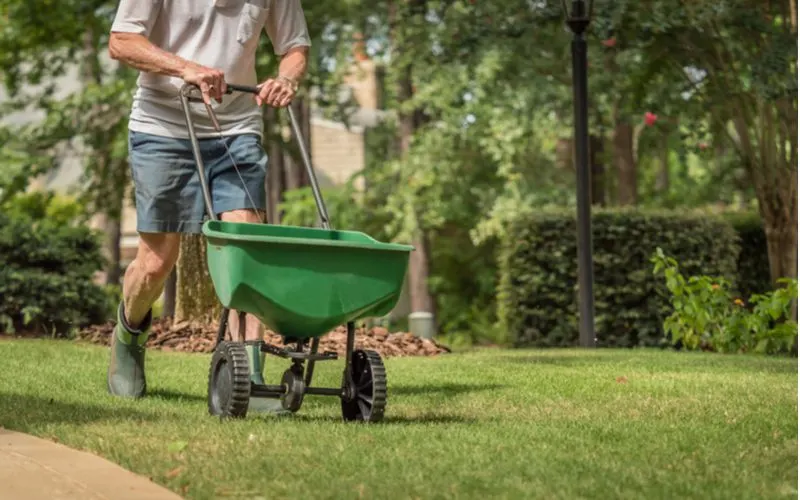
The Toidi/Shutterstock
If you’ve ever wished on a dandelion, you spread its seed. But how can such an innocent act completely ruin the look of your yard? Dandelion seeds exist in the fluffy flower, and when blown to bits, their existence prolongs.
Because dandelions spread their seeds so efficiently, it’s almost impossible to prevent them from showing up in your yard.
But there are preventative measures you can take to keep your lawn healthy, strong, and resilient to tall weeds. After you have dug them up, fertilizing the grass would be the next step in eliminating these weeds.
Additionally, a well-trimmed yard is less susceptible to dandelions than an untamed lawn. That’s not to say tall grass isn’t helpful. Mowing on a higher setting can prevent the sprouting and growth of new weeds. The key is to keep it in good health.
Treatment
Applying fertilizer to the soil can help your lawn defend itself against new weeds. As your lawn grows, it shades the weed seeds and prevents their maturation.
Finally, following a strict schedule to treat your lawn properly gives it the nutrients it needs to continuously protect itself against dandelions. There are also lawn treatments you can buy to prevent weed growth.
Most of these products are similar to the herbicides we mentioned earlier, and they contain grass killers such as acetic acid, clethodim, glyphosate, and sethoxydim.
Of course, use caution when applying any pesticides to your lawn; you wouldn’t want to prevent your healthy grass from growing.
Things to Consider
Here are some things to keep in mind when setting out to eliminate your dandelions.
- If not properly picked, dandelion roots can sprout new leaves and heads quickly.
- Remember, weed killers kill grass, too, so make sure to do your research or consult with an expert when applying herbicides.
- Lawn professionals can treat your lawn on a regular schedule to prevent weeds year-round.
- Homemade remedies can be cheaper, but always do diligent research before using chemicals on your lawn.
Frequently Asked Questions
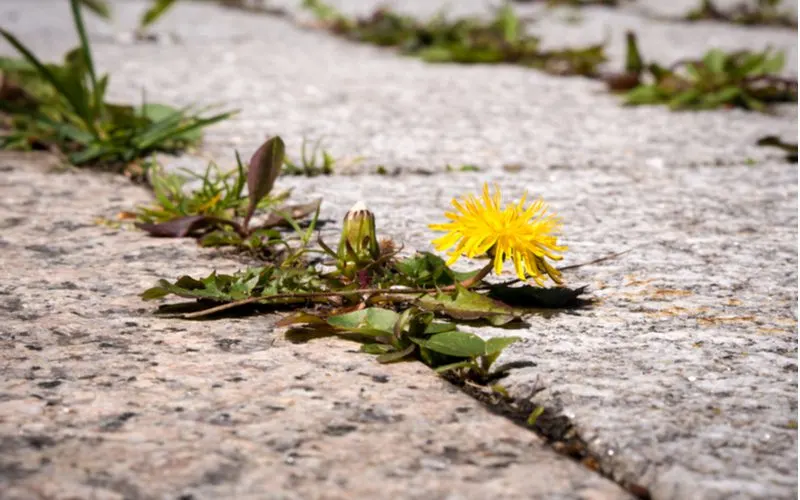
Floki/Shutterstock
How Do You Kill Dandelions Without Hurting the Grass?
Broadleaf herbicides are a good choice for those looking to treat dandelion weeds without harming their grass. Broadleaf herbicides will kill dandelion weeds and won't harm normal grass growth.
How Long Does a Dandelion Live?
Dandelions can survive for more than seven years in undisturbed sites. Some regions have reported dandelions sprouting for 10-13 years.
How Many Seeds do Dandelions Produce?
Dandelion plants can spread an average of 15,000 seeds in their lifetime. Because of this, there's no true way to rid your lawn of dandelions for good.
Are Dandelions Good for Your Yard?
Surprisingly enough, dandelions can offer numerous benefits to your lawn. For starters, they can loosen hard-packed soil with their wide-spreading roots.
The plant's deep taproot can even bring nutrients packed deep within the soil closer to the surface and make them more available to other plants.
When Do I Remove Dandelions?
Dandelions are broadleaf perennials that grow weak in the winter but don't die completely; they live underground during this time, surviving off the root.
The broad leaves bring nutrients to the root in the fall, making it the perfect time to treat and remove.
So, How Do You Get Rid of Dandelions?
By digging up the flower and the root and caring for your grass afterward, homeowners can bring the allure back to their lawns.
This requires time, attention, and willpower, but the steps are simple, so you can choose to hire a professional or follow them yourself.

